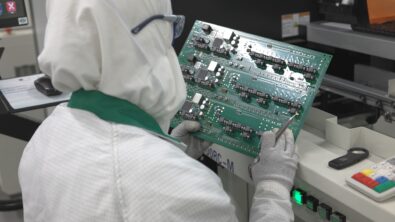The Three Pillars of Electronics Manufacturing for the Future

The dramatic growth in electronics over the last decade has caused a few trends to emerge. Electronics has become personal, driving companies to figure out how they can move from single part numbers in mass production to flexible, custom products manufactured in small lot sizes. With people increasingly on the go, they want to be able to take their electronics anywhere and to do more with their devices. We are seeing the explosive growth of smaller products with expanding features and functions.
Electronics are permeating every aspect of our lives, including products from mature industries such as white goods, or heavy consumer durables. A white goods company in China described how electronics was completely changing their industry, driven by consumer expectations of the functionality of their appliances, such as touch controls and remote programmability. But with challenges come opportunities: this company sees an opportunity to drive consumers to upgrade their washer or dryer in order to get these increased electronics capabilities, rather than waiting for the machines to break!
In the end, success or failure is really determined by the customer experience, both in how the product performs out of the box as well as its value over time. It seems like every Saturday I am searching for the closest electronics recycling location to drop off another set of electronics that are no longer (or maybe never even were) useful.
Consumers today want products that can fit their specific needs, or their specific style – a look that is unique to them. At the same time, they don’t want to wait to get their products. And they want them to work flawlessly. One exploding battery, or months of delay in shipping can severely damage your reputation, and impact your stock price.
In addition, you have to take into account the cost of both manufacturing and shipping. If you manufacture in a low-cost area but spend all your margins on shipping costs, you have not gained financial efficiencies.
The need to deliver a greater variety of products without compromising quality and time-to-market demands a new approach to Electronics Design and Manufacturing. We are seeing 3 pillars that are driving the requirements of that approach.
The first pillar: delivering lot size one
Being able to deliver a size one lot has several implications. The supplied product must respect quality, but you can’t test all possible variants without driving up cost and slowing time to market. Flexible production must be supported by systems that ensure quality processes are followed every time.
Productivity is also at risk. You can’t spend exorbitant time in station setup changes, logistics and complex planning.
The concept of product improvement shifts. You move from trying to improve a product to improving multiple product variants. You begin to focus on production processes, with analysis that must be supported by simulations.
Second pillar: optimizing material flow
With the cost of material increasing, electronics manufacturers are looking for new areas of usage optimization. They want to improve material flow to get a clear picture of the logistics to minimize waste and expiration. They are identifying secondary supply sources to overcome shortage of suitable parts. And, of course, they are leveraging just-in-time approaches to be able to bring just the needed quantity to the proper location exactly when it’s needed.
Third pillar: making data useful
The third big challenge is to properly analyze all data collected over lines, factories, and time. With Big Data technologies, what we have overcome are the physical processing limitations. But what we really need is a way to retrieve smart suggestions, enriched with relevant details, that are understandable and lead to the right decisions.
What needs to change
Today, the vast majority of production environments have not yet integrated planning with execution. Electronics and Mechanical departments may seem like two separate companies. It can seem like we have so far to go to even try to face the 3 big challenge pillars as we struggle with the day-to-day headaches. The supply chain manager is struggling with low material turnover, high scrap rate and low predictability. The quality engineer has a test plan that is not synchronized with the assembly plan and product changes. He finds it difficult to assess the quality of the entire product and misses the traceability records for the single items. The process planner is fighting with product data that is complex, outdated, hard to access, and not standardized across sites. The shop floor operator has work instructions that are not completely up-to-date and different machine interfaces to work with. IT manages outdated legacy information systems, trying to maintain multiple interfaces.
The approach suggested by Siemens it to start by breaking down the silos. Siemens has digitalized the entire value chain for Electronics Manufacturing, including
- Next-generation design and simulation
- Design verification to ensure right first time production
- Product lifecycle management to accelerate NPI globally
- Detailed scheduling for optimized production planning
- Production execution to ensure performance, utilization, and transparency
- Complete analysis and intelligence for continuous improvement.
The holistic Siemens approach also encompasses both the electronics and mechanical parts of the value chain. While these processes are different, they must come together in the manufactured product. It is crucial to leverage a single common backbone.
So, what are the main elements Siemens is using to address the modern manufacturing challenges in the electronics industry?
- The Product digital twin, to validate all product variants, including second-source components and latest bill of material
- The Production digital twin, to ensure first-time-right independently from the facility or specific manufacturing line
- Production planning, to minimize changeover impact with finite planning tools for the entire factory, including specific domain knowledge
- Material Management, to ensure on-time delivery of high-quality material, while minimizing logistics “traffic”
- Manufacturing Execution, to ensure all manufacturing processes are executed as defined by engineering, regardless of changes and high variance of products
- Manufacturing Intelligence, as the big data engine for manufacturing processes, with advanced capabilities for analysis and reporting.
As electronics manufacturers face increasing pressure from the 3 pillars describing the future of their industry, more and more are leveraging the Siemens approach to prepare for a leadership position in their market.

